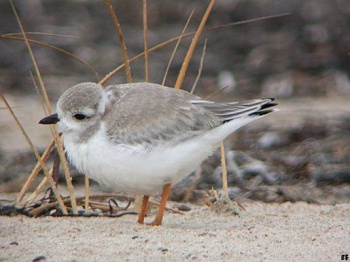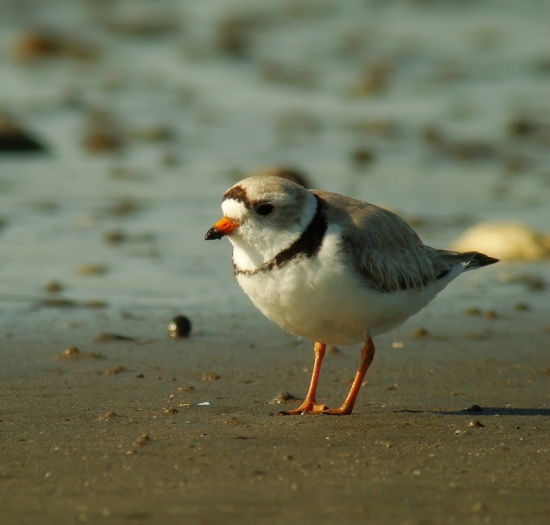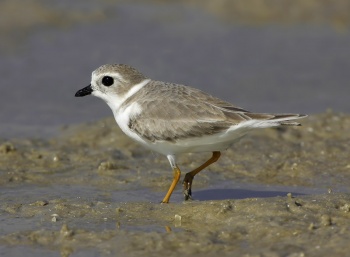(→External Links: Additional GSearch for common name, GSearch checked template) |
|||
| (3 intermediate revisions by the same user not shown) | |||
| Line 1: | Line 1: | ||
| − | {{ | + | [[Image:5-25-08 Piping Plover3.jpg|thumb|550px|right|Photo by {{user|robert+s|robert s}}<br />Milford Point Conn. Audubon Center, May 2009]] |
;[[:Category:Charadrius|Charadrius]] melodus | ;[[:Category:Charadrius|Charadrius]] melodus | ||
| − | |||
==Identification== | ==Identification== | ||
Sand-coloured, yellow-orange legs, black band across the forehead from eye to eye, and a black ring around the neck during the breeding season. Beak orange and black-tipped. | Sand-coloured, yellow-orange legs, black band across the forehead from eye to eye, and a black ring around the neck during the breeding season. Beak orange and black-tipped. | ||
| + | ====Similar Species==== | ||
| + | Differs from [[Kentish Plover|Kentish/Snowy Plover]] by multiple features. The beak of the Piping Plover is orange and black-tipped, as opposed to the Snowy's/Kentish's thinner, all-black beak. The Snowy/Kentish is also a darker sandy-brown color, and has an incomplete black collar and breastband (which Piping loses in the nonbreeding season, from September to February). Snowy/Kentish also has grayish legs as opposed to Piping's orange. Piping also lacks Snowy/Kentish's black cheek patch, but has a more pronounced white supercillium. | ||
| + | [[Image:Piping_Plover.jpg|thumb|350px|right|Winter plumage<br />Photo by {{user|chris+baker|chris baker}}<br />Estero Beach, Fort Myers, [[Florida]], [[USA]], November 2005]] | ||
==Distribution== | ==Distribution== | ||
Breeds eastern [[Canada]] and [[U.S.]], also southern [[Alberta]], [[Saskatchewan]], and [[Manitoba]], northern [[Montana]], western and central [[North Dakota]], central [[South Dakota]], and most of [[Nebraska]], localized populations in [[Colorado]] and the Great Lakes; winters southeastern U.S., [[Bahamas]] and [[Greater Antilles]]. | Breeds eastern [[Canada]] and [[U.S.]], also southern [[Alberta]], [[Saskatchewan]], and [[Manitoba]], northern [[Montana]], western and central [[North Dakota]], central [[South Dakota]], and most of [[Nebraska]], localized populations in [[Colorado]] and the Great Lakes; winters southeastern U.S., [[Bahamas]] and [[Greater Antilles]]. | ||
| + | ==Taxonomy== | ||
| + | This is a [[Dictionary_M-O#M|monotypic]] species<sup>[[#References|[1]]]</sup>. | ||
| + | |||
| + | Subspecies ''circumcinctus'' is generally considered invalid<sup>[[#References|[2]]]</sup>. | ||
| − | |||
| − | |||
==Habitat== | ==Habitat== | ||
| − | Sandy or gravel beaches or sandbars | + | Sandy or gravel beaches or sandbars and mudflats. |
| + | [[Image:1117020720 Piping Plover juvenile 0214.jpg|thumb|350px|right|Juvenile<br />Photo by {{user|Glen+Tepke|Glen Tepke}}<br />[[Allen's Pond Wildlife Sanctuary]], Dartmouth, [[Massachusetts]], [[USA]], July 2002]] | ||
| + | ====Status==== | ||
| + | Classified as Near Threatened, mainly due to beach disturbance.<sup>[[#References|[3]]]</sup>. | ||
==Behaviour== | ==Behaviour== | ||
| + | ====Movement==== | ||
| + | Typical plover 'run and stop' when feeding. Bobs the head. | ||
| + | ====Diet==== | ||
Diet includes insects, marine worms and crustaceans. | Diet includes insects, marine worms and crustaceans. | ||
| + | ====Vocalisation==== | ||
| + | Very vocal during the breeding season, making soft whistles whilst flutting close to the ground. | ||
| + | ==References== | ||
| + | #{{Ref-Clements6thDec09}}#Avibase | ||
| + | #BirdLife International | ||
| + | #Wikipedia | ||
| + | {{ref}} | ||
==External Links== | ==External Links== | ||
| + | Search the Gallery using the scientific name: | ||
{{GSearch|Charadrius+melodus}} | {{GSearch|Charadrius+melodus}} | ||
| + | <br /> | ||
| + | Search the Gallery using the common name: | ||
| + | {{GSearch|"Piping plover"}} | ||
| + | {{GS-checked}} | ||
| + | <br /> | ||
| + | <br /> | ||
| + | |||
[[Category:Birds]][[Category:Charadrius]] | [[Category:Birds]][[Category:Charadrius]] | ||
Latest revision as of 22:07, 12 February 2022
- Charadrius melodus
Identification
Sand-coloured, yellow-orange legs, black band across the forehead from eye to eye, and a black ring around the neck during the breeding season. Beak orange and black-tipped.
Similar Species
Differs from Kentish/Snowy Plover by multiple features. The beak of the Piping Plover is orange and black-tipped, as opposed to the Snowy's/Kentish's thinner, all-black beak. The Snowy/Kentish is also a darker sandy-brown color, and has an incomplete black collar and breastband (which Piping loses in the nonbreeding season, from September to February). Snowy/Kentish also has grayish legs as opposed to Piping's orange. Piping also lacks Snowy/Kentish's black cheek patch, but has a more pronounced white supercillium.
Distribution
Breeds eastern Canada and U.S., also southern Alberta, Saskatchewan, and Manitoba, northern Montana, western and central North Dakota, central South Dakota, and most of Nebraska, localized populations in Colorado and the Great Lakes; winters southeastern U.S., Bahamas and Greater Antilles.
Taxonomy
This is a monotypic species[1].
Subspecies circumcinctus is generally considered invalid[2].
Habitat
Sandy or gravel beaches or sandbars and mudflats.

Photo by Glen Tepke
Allen's Pond Wildlife Sanctuary, Dartmouth, Massachusetts, USA, July 2002
Status
Classified as Near Threatened, mainly due to beach disturbance.[3].
Behaviour
Movement
Typical plover 'run and stop' when feeding. Bobs the head.
Diet
Diet includes insects, marine worms and crustaceans.
Vocalisation
Very vocal during the breeding season, making soft whistles whilst flutting close to the ground.
References
- Clements, JF. 2009. The Clements Checklist of Birds of the World. 6th ed., with updates to December 2009. Ithaca: Cornell Univ. Press. ISBN 978-0801445019.
- Avibase
- BirdLife International
- Wikipedia
Recommended Citation
- BirdForum Opus contributors. (2024) Piping Plover. In: BirdForum, the forum for wild birds and birding. Retrieved 11 May 2024 from https://www.birdforum.net/opus/Piping_Plover
External Links
Search the Gallery using the scientific name:
Search the Gallery using the common name:
GSearch checked for 2020 platform.





